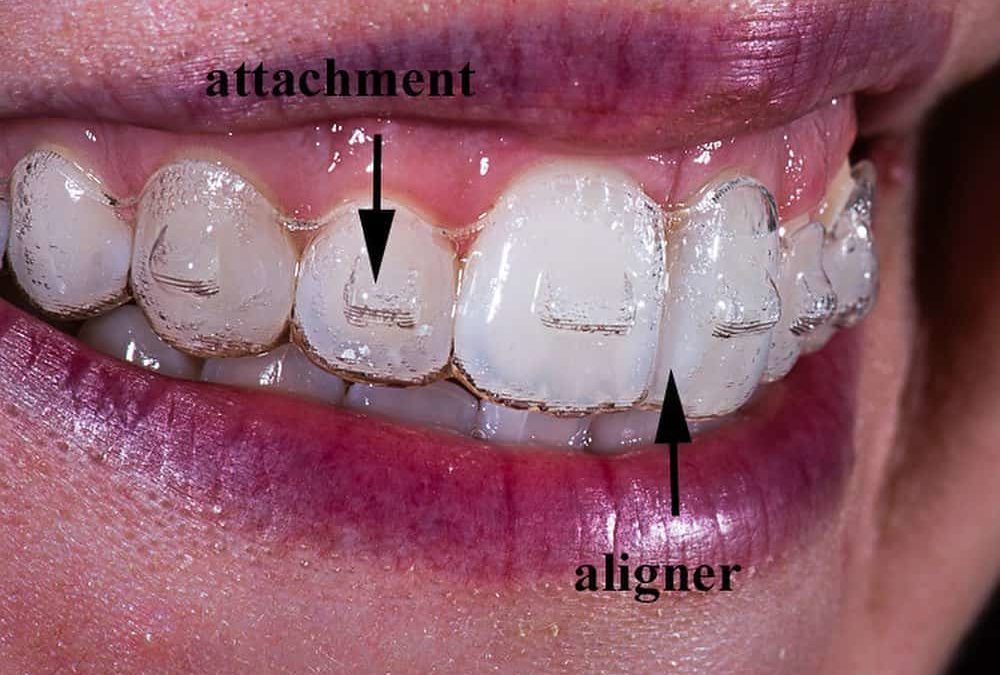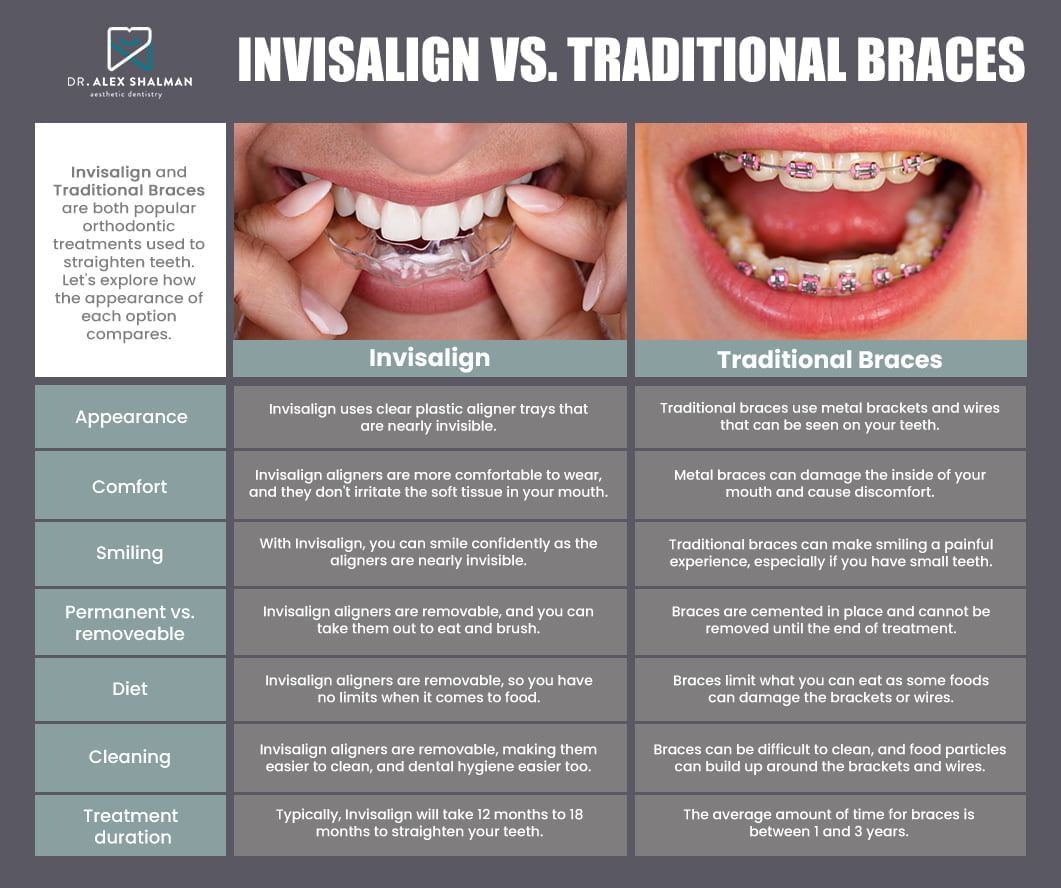Invisalign vs. Conventional Dental braces: Which Alternative Is Right for You?
When taking into consideration orthodontic treatment, the option in between Invisalign and conventional braces provides a number of vital aspects that warrant mindful analysis. Invisalign uses a discreet choice with removable aligners, while traditional braces provide a more noticeable yet reliable solution for severe misalignment.
Overview of Treatment Options

On the other hand, typical braces contain steel brackets and cords that are bonded to the teeth. This approach applies continual stress over time to achieve alignment. While effective for complex orthodontic issues, standard braces require routine check outs for adjustments and can position obstacles in keeping oral health as a result of the problem of cleaning about wires and brackets.
Both options have their merits, and the option frequently pivots on specific dental conditions, way of life choices, and person conformity. Eventually, consulting an orthodontic expert is critical for identifying one of the most appropriate treatment strategy tailored to specific demands. Recognizing the nuances of each option can considerably affect the overall success of orthodontic treatment.
Visual Considerations
A substantial variable influencing the choice in between Invisalign and typical braces is the aesthetic allure each therapy offers. Invisalign aligners are crafted from clear plastic, making them essentially unnoticeable when worn. This very discreet appearance is particularly attracting adults and teens who may really feel self-conscious regarding their orthodontic treatment. The capability to maintain an all-natural smile throughout the alignment process can significantly enhance the client's confidence in social and specialist setups.
On the other hand, typical dental braces contain metal braces and wires, which can be more recognizable. While improvements in orthodontic technology have actually resulted in the growth of smaller sized braces and tinted elastics, typical braces still preserve a more obvious profile. For some individuals, the visibility of braces may discourage them from looking for essential treatment.
Eventually, the choice in between Invisalign and typical dental braces may depend upon personal preferences pertaining to appearances. Patients who focus on discretion commonly lean toward Invisalign, while those that are less worried concerning exposure might choose traditional dental braces. Recognizing the aesthetic ramifications of each alternative is important for making a notified choice that lines up with one's way of life and choices.
Comfort and Convenience

In regards to comfort, Invisalign aligners are removable, making it possible for individuals to enjoy their preferred foods without constraint and keep optimum oral hygiene. Brushing and flossing are streamlined, as the aligners can be obtained throughout these routines, whereas standard braces reference need careful maneuvering around cables and braces.
Additionally, Invisalign's modern system permits fewer orthodontic brows through. Clients generally obtain multiple collections of aligners at the same time, which can streamline the therapy process and minimize time invested in the orthodontist's chair. In comparison, standard dental braces require regular changes, making them much less practical for those with active routines. Invisalign. Overall, the comfort and benefit of Invisalign make it an appealing selection for lots of individuals seeking orthodontic therapy.
Therapy Period and Performance
While both Invisalign and traditional dental braces are efficient in correcting oral imbalances, the duration of therapy can differ dramatically in between both options. Typically, Invisalign therapy can take anywhere from 12 to 18 months, depending upon the complexity of the instance. The clear aligners function by progressively shifting teeth right into their wanted placements, and regular follow-ups with an orthodontist aid ensure progression continues to be on course.
In contrast, traditional dental braces often require a longer dedication, generally ranging from 18 months to 3 years. This is because of their set nature and using cords and braces, which can be extra reliable for serious imbalances and complex instances (Invisalign). The treatment efficiency of typical dental braces is well-documented, as they enable exact modifications and greater control over tooth movement
Eventually, the selection between Invisalign and typical braces may rest on both the awaited therapy period and the details oral issues handy. Consulting with an orthodontist is important, as they can give customized recommendations based upon private demands, guaranteeing the selected technique lines up with desired durations and results.
Expense Comparison and Insurance Policy Options
Cost plays a significant function in the decision-making procedure for individuals thinking about orthodontic treatment, whether selecting Invisalign or conventional dental braces. On standard, the price of Invisalign arrays from $3,000 to $8,000, while conventional dental braces typically cost in between $2,000 and $6,000. Aspects affecting these costs include the intricacy of the case, the duration of treatment, and geographical place.
Insurance protection can significantly impact out-of-pocket costs. Numerous dental insurance policy plans supply partial coverage for orthodontic treatments, but the specifics can differ commonly. It is important for people to review their insurance plan to identify the degree of protection for either option. Generally, conventional dental braces might be a lot more frequently covered by insurance plans contrasted to Invisalign, which some insurance firms classify as an aesthetic treatment.
In addition, numerous orthodontic practices offer flexible layaway plan, making both Clicking Here therapy options a lot more easily accessible. Clients need to ask about potential funding alternatives and price cuts for ahead of time settlements. Examining the total price, including insurance benefits and payment plans, is necessary for making a notified choice that lines up with both aesthetic preferences and budget plan considerations.

Conclusion
In summary, the choice between Invisalign and traditional dental braces pivots on multiple variables, consisting of aesthetic preferences, convenience, treatment duration, and price. Invisalign supplies a very discreet, removable choice that promotes oral health and dietary versatility, while typical braces may be much more suitable for complex oral concerns and usually come with a lower cost factor. Inevitably, assessment with an orthodontist is vital to evaluate specific scenarios and determine the most suitable therapy choice for accomplishing optimal dental alignment.
When considering orthodontic treatment, the option in between Invisalign and traditional dental braces offers numerous essential factors that navigate to this website merit careful evaluation.Comparing Invisalign and conventional braces reveals distinct therapy options for orthodontic adjustment.While both Invisalign and typical braces are effective in fixing oral misalignments, the period of treatment can vary significantly between the 2 alternatives.Expense plays a considerable function in the decision-making process for people thinking about orthodontic treatment, whether deciding for Invisalign or typical braces.In recap, the selection in between Invisalign and typical dental braces pivots on several factors, including aesthetic choices, convenience, therapy period, and expense.